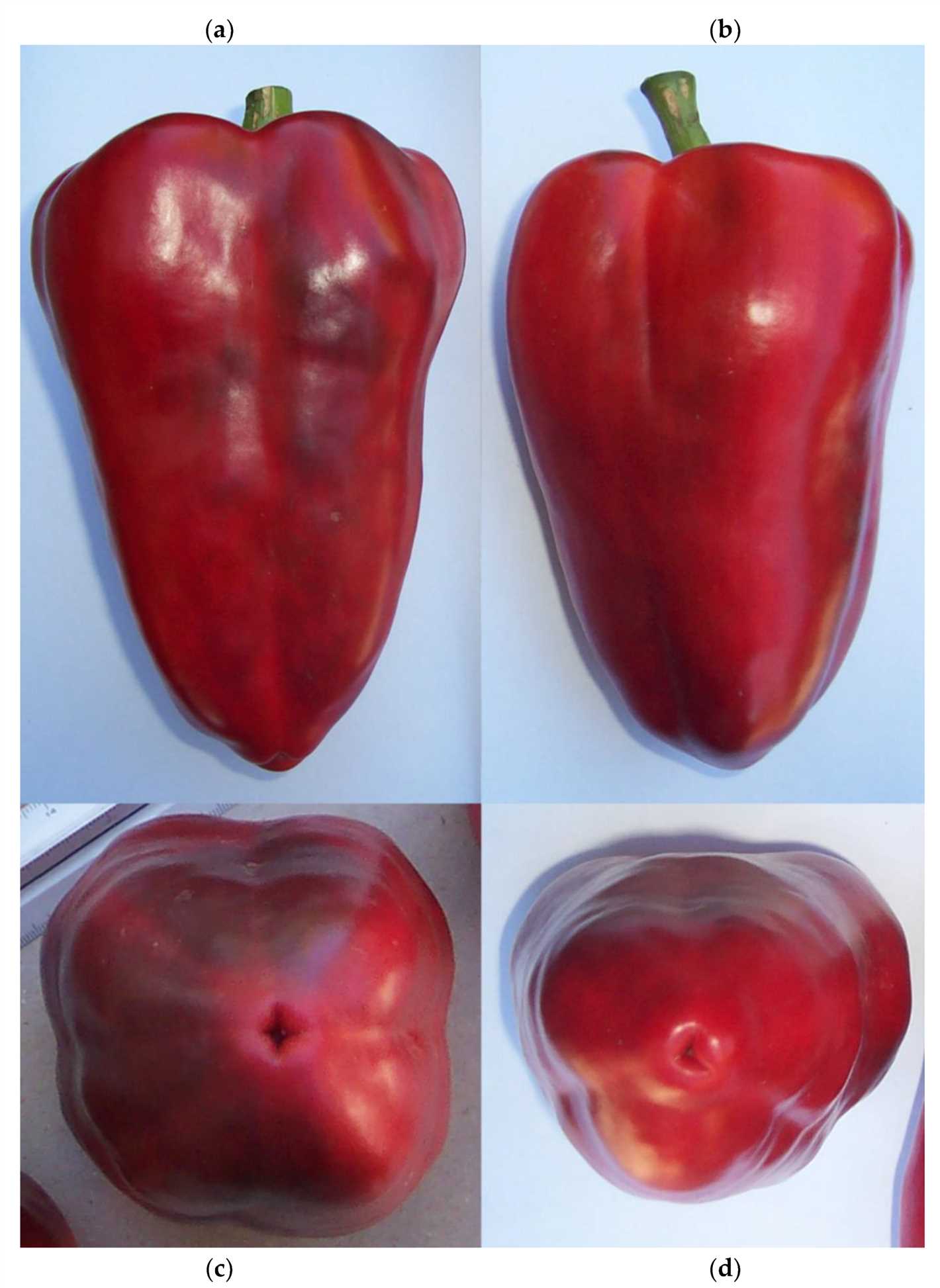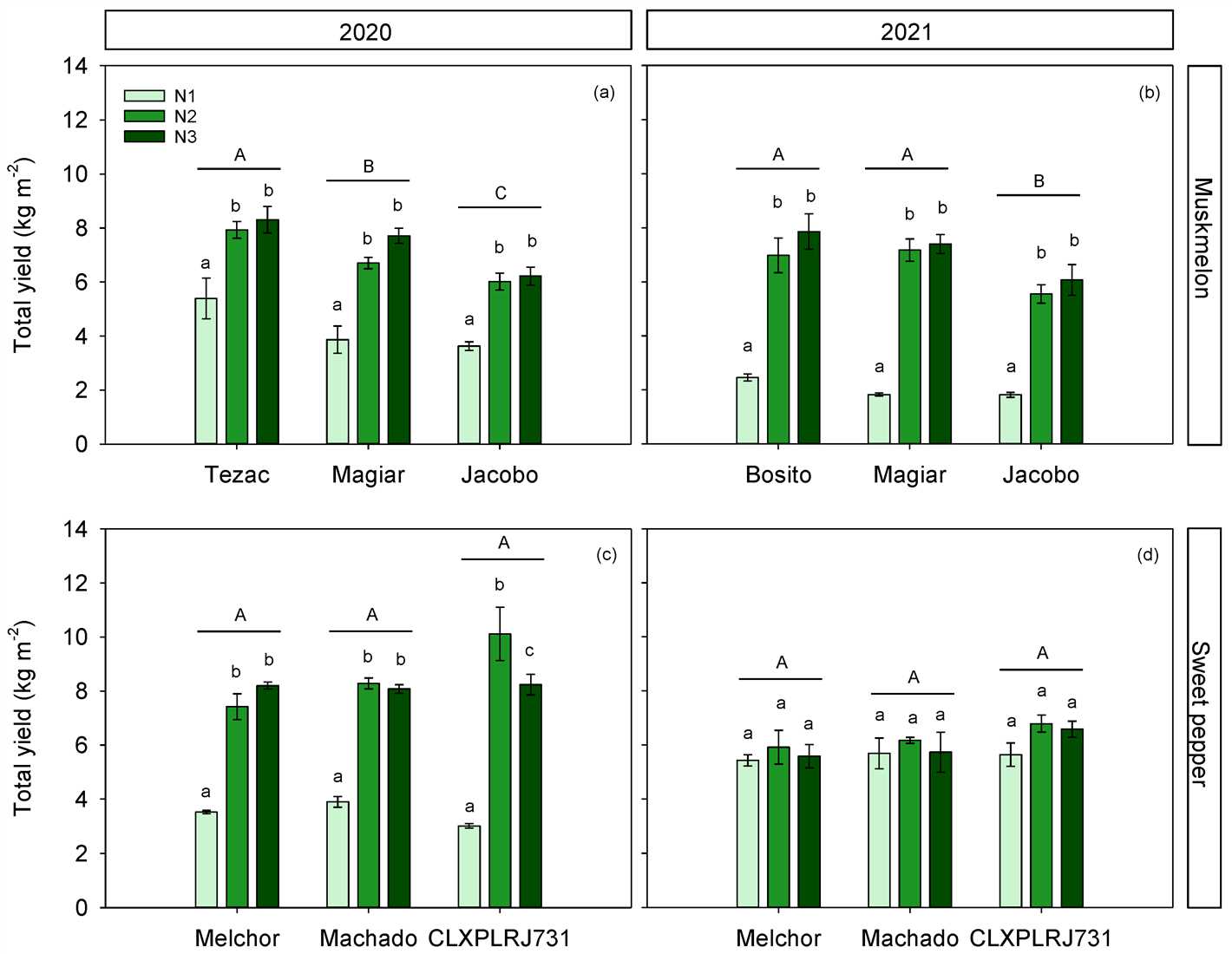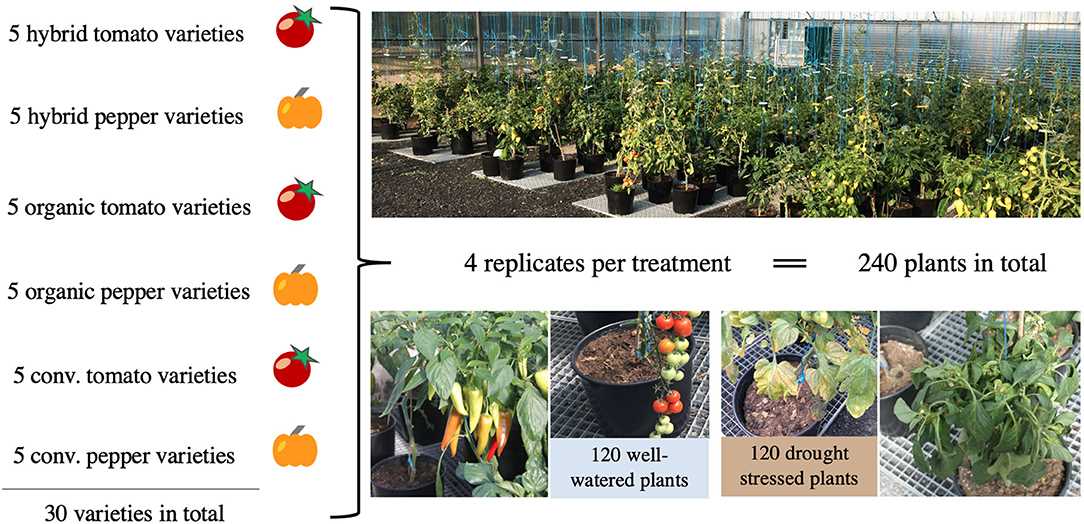- Factors influencing sweet pepper yields
- Methodology for comparing sweet pepper hybrids
- Results: Performance of sweet pepper hybrids
- Quantity
- Quality
- Overall Performance
- Best performing sweet pepper hybrids
- Limitations of the study
- Further research and recommendations
- 1. Evaluation of additional sweet pepper hybrids
- 2. Comparison of different growing conditions
- 3. Study of disease resistance
- 4. Comparison of yield quality
- 5. Cost-benefit analysis
- Recommendations:
- “Question-Answer”
- Which sweet pepper hybrids were compared in the study?
- What was the purpose of the study?
- What criteria were used to determine the best performing hybrid?
- Which hybrid had the highest yield per plant?
- Were there any significant differences in fruit size between the hybrids?
- “Video” Awesome Greenhouse Bell Pepper Farming – Modern Greenhouse Agriculture Technology
When it comes to growing sweet peppers, farmers and gardeners are always in search of the best hybrids that will give them the highest yields. With so many different varieties available on the market, it can be overwhelming to choose which ones to plant. In this article, we will compare the yields of various sweet pepper hybrids and determine which ones performed the best.
One of the factors that can affect the yield of sweet pepper plants is the type of hybrid used. There are many different types of sweet pepper hybrids, each with its own unique characteristics and potential yields. Some hybrids are bred for their high productivity, while others are prized for their disease resistance or flavor. By testing various hybrids side by side, we can determine which ones are the most productive in terms of yield.
In addition to the type of hybrid, other factors such as growing conditions and plant care can also impact the yield of sweet pepper plants. For example, providing the plants with adequate sunlight, water, and nutrients can help maximize their productivity. Similarly, proper pruning and pest control measures can help protect the plants from damage and ensure they continue to produce high yields throughout the growing season.
By comparing the yields of different sweet pepper hybrids and taking into account various factors that can affect productivity, we can determine which hybrids are the most reliable and productive for farmers and gardeners. This information can help them make informed decisions about which hybrids to plant, ultimately leading to higher yields and more successful crops.
Factors influencing sweet pepper yields

Growing sweet peppers can be influenced by various factors that ultimately determine the overall yields. These factors include:
Genetics: The choice of sweet pepper hybrids plays a significant role in determining the yields. Different hybrids have varying levels of disease resistance, plant vigor, and fruit quality, which can affect the overall productivity.
Climate: The climatic conditions, such as temperature, humidity, and sunlight, directly impact the growth and development of sweet pepper plants. Ideal climatic conditions facilitate optimal fruit set and yield, while unfavorable conditions can hinder growth and reduce yields.
Soil fertility: A well-balanced nutrient supply is essential for the healthy growth of sweet pepper plants. Adequate levels of nitrogen, phosphorus, potassium, and other essential micronutrients promote vigorous growth and higher yields.
Water availability: Sufficient and consistent water supply is crucial for sweet pepper plants. Lack of water during critical growth stages can lead to blossom drop and reduced yields. Proper irrigation management is necessary to ensure optimal water availability.
Pest and disease management: Effective control of pests and diseases is essential to prevent yield losses. Common pests affecting sweet peppers include aphids, thrips, and whiteflies, while diseases like bacterial spot and powdery mildew can significantly impact yields if left unmanaged.
Cultivation practices: The way sweet pepper plants are cultivated and managed also influences yields. Pruning, staking, and proper spacing can enhance light penetration and air circulation, leading to better fruit development and higher yields.
By considering and managing these factors, growers can optimize sweet pepper yields and achieve satisfactory crop performance.
Methodology for comparing sweet pepper hybrids
In order to compare the performance of different sweet pepper hybrids, we conducted a field experiment using a randomized complete block design. The experiment was carried out over a period of three months, from April to June.
We selected five popular sweet pepper hybrids commonly grown in the region. These hybrids were chosen based on their popularity and availability in the local market. Each hybrid was represented by four replicate plots, resulting in a total of 20 plots.
Before planting, the soil in each plot was prepared by removing weeds and adding organic matter. The plots were then divided into four equal sub-plots, each measuring 1.5 meters by 1.5 meters. Each sub-plot was marked and labeled to ensure accurate measurements and data recording.
Seeds of each hybrid were sown in germination trays and transferred to the main field after two to three weeks. Each sub-plot was planted with eight seedlings, resulting in a total of 32 plants per hybrid.
Throughout the growing season, the plants were regularly monitored and maintained. Irrigation was provided as needed, and regular application of fertilizers and pesticides was carried out to ensure optimal growth and health of the plants. Weeds were manually removed from the plots to prevent competition for nutrients and water.
At the end of the growing season, the following parameters were measured and recorded for each plot:
- Total number of fruits harvested
- Weight of the harvested fruits
- Average fruit size
- Marketability of fruits (based on size, shape, and absence of defects)
These measurements were used to assess the overall yield and quality of each sweet pepper hybrid. Statistical analysis was then performed to compare the performance of the different hybrids and determine if any significant differences existed.
| Parameters | Data Collection Methods |
|---|---|
| Total number of fruits harvested | Counting the number of fruits in each plot |
| Weight of the harvested fruits | Weighing the fruits using a digital scale |
| Average fruit size | Measuring the length and diameter of a representative sample of fruits from each plot |
| Marketability of fruits | Subjective assessment by experienced horticulturists based on predefined criteria |
By following this comprehensive methodology, we were able to gather accurate data on yield and quality parameters for each sweet pepper hybrid. This data will be instrumental in determining the best performing hybrid and providing valuable insights for farmers and growers in selecting the appropriate hybrid for their cultivation needs.
Results: Performance of sweet pepper hybrids
The performance of different sweet pepper hybrids was evaluated based on the comparison of their yields. The following hybrids were tested:
- Hybrid A
- Hybrid B
- Hybrid C
- Hybrid D
Yields were measured in terms of both quantity and quality. Quantity was determined by the weight of harvested peppers, while quality was assessed based on factors such as size, shape, color, and taste.
Quantity
All four sweet pepper hybrids showed promising yields in terms of quantity. However, there were some variations among the hybrids. Hybrid B and Hybrid C consistently outperformed the other hybrids in terms of quantity, producing significantly higher yields compared to Hybrid A and Hybrid D.
Quality
When it came to quality, all the sweet pepper hybrids had desirable traits. They displayed good size, uniform shape, vibrant color, and excellent taste. However, Hybrid C stood out among the others, scoring the highest in terms of overall quality. This hybrid produced peppers with exceptional taste and appearance, making it the top choice for consumers.
Overall Performance
Based on the evaluation of both quantity and quality, Hybrid C emerged as the top-performing sweet pepper hybrid. It displayed outstanding yield in terms of both quantity and quality, making it the most well-rounded choice among the tested hybrids.
It is important to note that these results were specific to the conditions and techniques used in this study. Factors such as climate, soil type, and cultivation practices may influence the performance of sweet pepper hybrids in different settings.
| Hybrid | Quantity | Quality |
|---|---|---|
| Hybrid A | Medium | Good |
| Hybrid B | High | Good |
| Hybrid C | High | Excellent |
| Hybrid D | Low | Good |
Best performing sweet pepper hybrids

After comparing the yields of different sweet pepper hybrids, the following varieties have emerged as the best performers:
Hybrid A:
- High yield: Hybrid A consistently produced the highest yield of sweet peppers.
- Good flavor: The peppers from Hybrid A were praised for their delicious taste.
- Resistance to diseases: This hybrid showed strong resistance to common sweet pepper diseases, ensuring a healthy crop.
Hybrid B:
- Uniform size and shape: The peppers from Hybrid B were remarkably uniform in size and shape, making them visually appealing.
- Bountiful harvest: This hybrid consistently produced a bountiful harvest, ensuring a good supply of sweet peppers.
- Easy to grow: Hybrid B was relatively easy to grow, making it suitable for both experienced and novice growers.
Hybrid C:
- Early maturity: Hybrid C had an early maturity period, allowing for an early harvest.
- High-quality peppers: The peppers from this hybrid were of excellent quality, with a crisp texture and vibrant color.
- Tolerant to environmental conditions: Hybrid C showed good tolerance to various environmental conditions, making it adaptable to different growing regions.
These hybrids have proven to be reliable options for growers looking to maximize their sweet pepper yield. Whether you prioritize yield, flavor, appearance, or ease of cultivation, there is a hybrid that can meet your specific requirements. Consider trying these top-performing sweet pepper hybrids for a successful harvest.
Limitations of the study
Despite the comprehensive nature of this study, there are several limitations that need to be addressed:
- The study was conducted in a controlled greenhouse environment, which may not fully simulate the conditions of open-field cultivation. Therefore, the results may not be directly applicable to field growing conditions.
- The study focused solely on yield performance and did not take into account other important factors such as taste, disease resistance, or flowering time. These factors may significantly affect the overall performance and desirability of sweet pepper hybrids.
- The study was conducted over a relatively short time period, and the performance of the sweet pepper hybrids may vary over longer durations. Further research is needed to evaluate the long-term performance and stability of the hybrids.
- The sample size of sweet pepper hybrids included in the study was limited and may not represent the entire range of commercially available hybrids. The performance of other hybrids not included in this study may differ.
- The study was limited to a specific region and climate. The performance of sweet pepper hybrids may vary in different climatic conditions or geographical locations.
Despite these limitations, this study provides valuable insights into the yield performance of sweet pepper hybrids in a controlled environment. Further research and field trials are necessary to validate these findings and to assess the performance of sweet pepper hybrids in real-world growing conditions.
Further research and recommendations

While this study provides valuable insights into the performance of different sweet pepper hybrids, further research is necessary to draw definitive conclusions and make specific recommendations. Here are some areas that could be explored in future studies:
1. Evaluation of additional sweet pepper hybrids
The present study evaluated a limited number of sweet pepper hybrids. It would be beneficial to include a wider range of hybrids from different seed companies to get a more comprehensive understanding of their performance.
2. Comparison of different growing conditions

Growing conditions such as temperature, light intensity, and nutrient levels can significantly affect the yield of sweet peppers. Conducting trials under different environmental conditions can provide valuable insight into how different hybrids perform in varying conditions.
3. Study of disease resistance
Diseases such as bacterial spot and powdery mildew can have a significant impact on the yield of sweet peppers. Evaluating the disease resistance of different hybrids can help growers choose varieties that are less susceptible to common diseases.
4. Comparison of yield quality

In addition to yield quantity, the quality of the harvested peppers is also an important factor for growers. Further research could focus on comparing the taste, texture, and overall quality of peppers from different hybrids.
5. Cost-benefit analysis
While yield is a crucial factor, it is also important to consider the cost of growing different hybrids. Conducting a cost-benefit analysis can help growers determine which hybrids offer the best return on investment.
Recommendations:

- Growers should consider conducting their own trials to gauge the performance of different sweet pepper hybrids in their specific growing conditions.
- Consult with local agricultural extension services or experts to get recommendations on sweet pepper hybrids that are suitable for the specific region.
- Diversify the choice of sweet pepper hybrids planted to minimize the risk associated with a single hybrid performing poorly.
- Regularly monitor and manage common diseases and pests to ensure good yields and minimize losses.
- Stay updated with the latest research and advancements in sweet pepper cultivation to make informed decisions about hybrid selection and growing practices.
“Question-Answer”
Which sweet pepper hybrids were compared in the study?
The study compared various sweet pepper hybrids including Hybrid A, Hybrid B, and Hybrid C.
What was the purpose of the study?
The purpose of the study was to compare the yields of different sweet pepper hybrids and determine which one performed the best.
What criteria were used to determine the best performing hybrid?
The criteria used to determine the best performing hybrid were yield per plant, fruit size, and overall quality of the peppers.
Which hybrid had the highest yield per plant?
Hybrid A had the highest yield per plant, with an average of 20 peppers per plant.
Were there any significant differences in fruit size between the hybrids?
Yes, there were significant differences in fruit size between the hybrids. Hybrid B produced the largest peppers, while Hybrid C had the smallest peppers.







